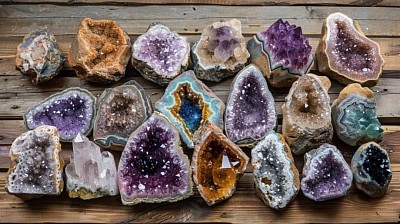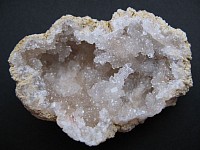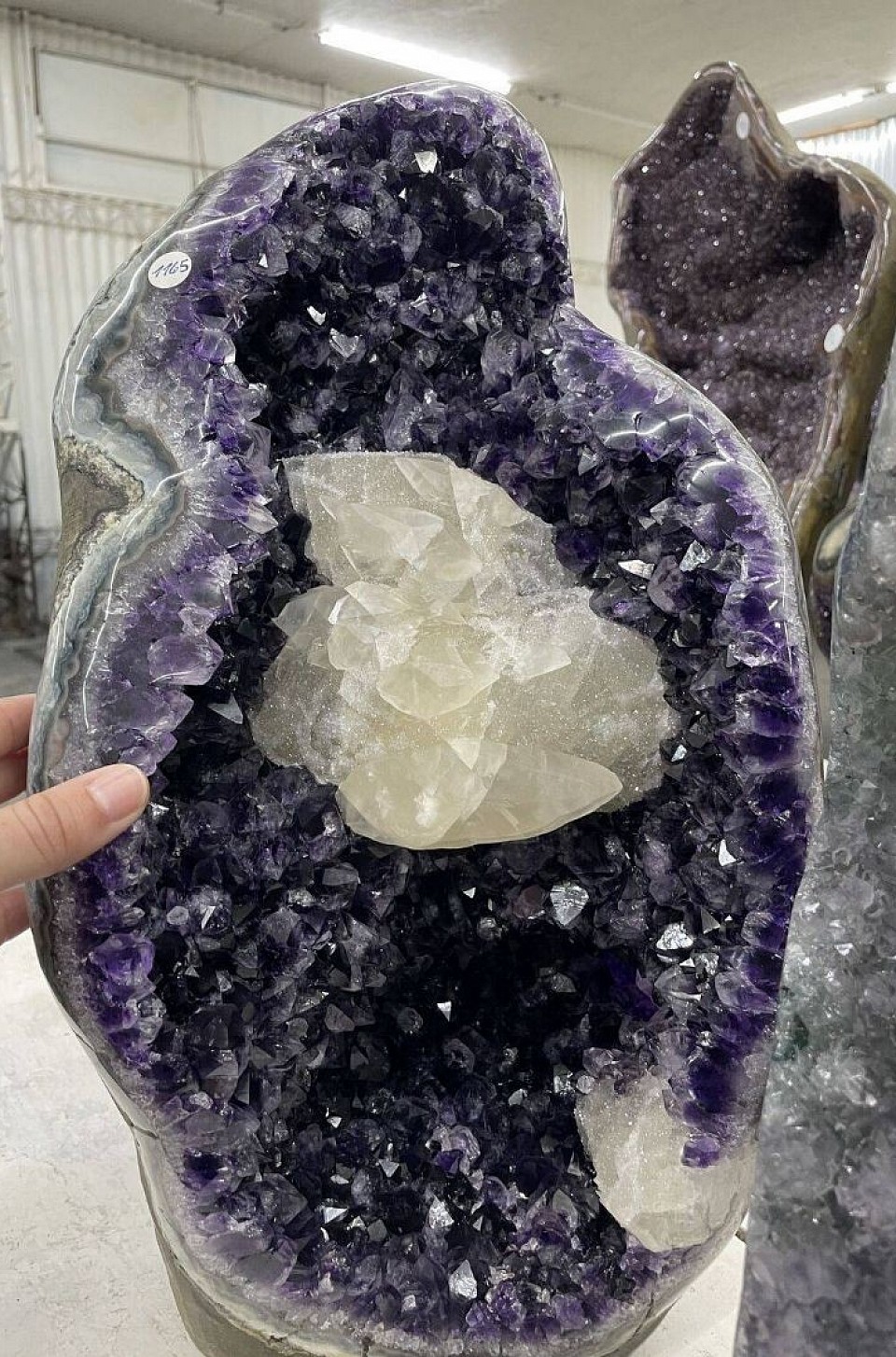Geodes: Comprehensive Geological Study and Detailed Analysis
I. Distinctive Characteristics and Visual Appearance of Geodes: Defining Features and Identification
Morphology and External Features
Geodes are typically hard, discrete rocky structures most commonly found in oval, nearly spherical, or globular forms. However, their shapes can be surprisingly varied, extending beyond typical ball or egg-like configurations to include oblong, triangular, square, cylindrical, or even teardrop shapes. This diversity reflects the wide range of geological conditions under which geodes form.
In terms of size, geodes range from tiny specimens less than 0.1 inches in diameter—smaller than a pea—to colossal structures several feet across. While most commonly encountered geodes measure between 2 and 6 inches in diameter, exceptionally large examples exist. For instance, some geodes found in the Paraná Basin of South America and Brazil are so immense that they can accommodate a person inside, illustrating the extraordinary scale some formations can achieve.
The outer surface of a geode is characteristically rugged, rough, bumpy, or lumpy, often appearing in shades of gray to brownish. This exterior texture can sometimes resemble a "cauliflower-like appearance." The outermost layer, or rind, is primarily composed of chalcedony, a dense microcrystalline form of quartz. The thickness of this rind varies considerably, from a thin film to over an inch, and does not necessarily correlate with the overall size of the geode.
This chalcedony rind plays a crucial dual role. Its inherent hardness and superior weather resistance compared to the surrounding host rocks enable geodes to withstand erosion and remain intact even as the softer enclosing rock wears away. This explains why geodes are frequently found as isolated, complete specimens in weathered environments. Furthermore, the distinctive presence and often bumpy texture of this chalcedony layer make it a key characteristic for field identification by collectors. The material properties of chalcedony directly influence these observable characteristics, contributing significantly to the prevalence and collectability of geodes.
Internal Structure and Crystal Formation
The defining characteristic of a geode is its internal cavity, which is lined with mineral masses or crystals that grow inward toward the center. These crystals typically nucleate and develop from the inner walls of the outer shell. Many geodes feature "druzy" (or drusy) minerals, characterized by numerous small, well-formed crystals projecting inward, creating a sparkling fabric.
The mineral composition within the geode's interior is distinct from that of the surrounding host rock. The initial layer formed is frequently chalcedony, upon which subsequent layers of other minerals precipitate and grow. Beyond typical crystal forms, chalcedony within geodes can also display a botryoidal habit, resembling clusters of grapes. Some geodes may exhibit dendrites, intricate tree-like mineral patterns that add to their visual complexity.
Mineralogy and Coloration
The most commonly observed crystals within geodes include quartz (encompassing varieties such as clear quartz, smoky quartz, and milky quartz), calcite, and fluorite. Amethyst, a purple variety of quartz, is particularly prized for its deep hues. Chalcedony, in addition to forming the outer rind, can also constitute inner layers.
A diverse array of less common minerals can also be found, including dolomite, aragonite, ankerite, hematite, magnetite, pyrite, chalcopyrite, and sphalerite. More unusual occurrences include delicate blue celestine crystals, barite, and even opal. A notable example is the Giant Geode of Pulpí in Spain, renowned for its extraordinarily large gypsum (selenite) crystals.
The arrangement of minerals within a geode can be layered; for instance, metal sulfides often form the innermost layer, followed by a layer of calcite, and then the outer chalcedonic layer. Occasionally, a second layer of chalcedony may be present.
The vibrant colors displayed by geode crystals are not arbitrary aesthetic features but are primarily determined by the specific chemistry and trace impurities present in the mineral-rich fluids during their formation. For example:
- Iron imparts red, purple, or rusty appearances and is responsible for the deep purple hue in amethyst.
- Titanium creates blue coloration.
- Manganese produces a pinkish hue.
- Chromium or nickel result in green colors.
- Cobalt can also yield red coloration.
This precise relationship between trace impurities and crystal coloration means that the colors are direct chemical signatures of the geological environment and the specific composition of the mineral-rich fluids present during formation. Consequently, geodes serve as valuable geochemical records, allowing scientists to infer past conditions and the availability of certain elements in the Earth's crust.
Additionally, the presence of minerals with clear surfaces and numerous facets allows them to reflect light, creating a sparkling and beautiful appearance that further enhances their aesthetic appeal.
Introduction to Geodes: Discovering the Geological Wonders and Crystal Formations of Nature's Hidden Cavities
Table 1: Common Geode Minerals and Their Color Associations
| Mineral Name | Common Colors | Associated Impurities/Factors | Notes |
|---|---|---|---|
| Quartz | Clear, White, Smoky Brown | Trace minerals, Irradiation | Most common crystal |
| Amethyst | Deep Purple | Iron impurities | Prized for rarity and beauty; can be heat-treated to form Citrine |
| Calcite | White, Clear | Various impurities | Less common than quartz; known for double refraction |
| Fluorite | Various (often green, purple, blue) | Trace elements | Found in some geodes |
| Chalcedony | Grayish-white, various banded colors | Microcrystalline quartz, impurities | Forms outer shell and inner layers; can be banded (agate) |
| Celestine | Delicate Blue | Strontium | Prized for ethereal beauty |
| Gypsum (Selenite) | Clear, White | Calcium sulfate | Forms exceptionally large crystals in some unique geodes (e.g., Pulpí) |
| Pyrite | Metallic Yellow | Iron sulfide | Often forms innermost layer |
| Hematite | Reddish-brown | Iron oxide | Can impart red/rusty hues |
| Aragonite | White, various | Calcium carbonate | Less common, found in specific localities |
Geode Formation: A Slow and Complex Geological Process
Geode formation is a slow, intricate geological process that typically spans thousands to millions of years. It involves two critical stages: first, the creation of an initial hollow space within a host rock, and second, the sustained infiltration and precipitation of mineral-rich fluids into that void. The geological setting—whether volcanic or sedimentary—determines the mechanism of void formation, which in turn influences the chemistry of the fluids and the internal mineralogy of the geode.
Formation in Volcanic Rocks
In volcanic environments, geodes begin as hollow spaces formed by gas bubbles trapped within cooling lava flows, similar to air pockets in bread. These gas pockets create the initial cavities that later develop into geodes. Over extended geological periods, mineral-rich hydrothermal fluids seep into these cavities from the surrounding volcanic rock. As these fluids cool or undergo chemical changes, dissolved minerals precipitate out, gradually depositing distinct bands or layers of crystals along the cavity walls.
Formation in Sedimentary Rocks
In sedimentary settings such as limestone, dolomite, or shale, cavities form differently. They may originate from the decay of organic matter like buried roots or animal burrows, or from pre-existing gaps within the rock. Mineral-rich groundwater slowly infiltrates these voids, and as water evaporates or chemical conditions shift, dissolved minerals—particularly carbonates—precipitate and crystallize along the inner walls, creating the characteristic geode interior.
Crystallization and Growth
Crystallization typically starts with minerals forming on the outer shell walls, often chalcedony, followed by inward growth of other crystals toward the center. This continuous deposition results in the distinctive crystalline interior that defines geodes.
The formation process is remarkably slow, often requiring immense geological timescales. Developing large, well-formed crystals may take tens or even hundreds of millions of years. For example, crystals inside the Giant Geode of Pulpí in Spain are estimated to be at least 165,000 years old, with crystallization possibly starting much earlier. The type and quality of crystals depend heavily on the minerals dissolved in the infiltrating water and the prevailing environmental conditions such as temperature, pressure, and chemistry over these vast periods. These slow and varying conditions contribute to the immense diversity observed among geode varieties worldwide.
Ostwald Ripening and Scientific Significance
The formation of exceptionally large crystals, like those in the Pulpí Geode, involves Ostwald ripening—a process where smaller, more soluble crystals dissolve, and their material redeposits onto larger, less soluble crystals, progressively increasing their size. This mechanism explains the perfection and scale of some geode crystals.
Beyond their aesthetic appeal, geodes serve as invaluable scientific archives. Studying their internal structures, crystal compositions, and especially the tiny fluid inclusions trapped within crystals provides direct evidence of past hydrological cycles, fluid flow pathways, and geochemical conditions (temperature, pressure, chemical composition) deep within the Earth's crust over geological epochs. This makes geodes crucial tools for reconstructing ancient Earth systems and understanding long-term geological evolution.
Global and Regional Distribution of Geode Deposits
Geodes are found worldwide, with certain regions renowned for their abundance and unique specimens. The geological context, including host rock type and mineral-rich fluid composition, fundamentally determines the internal mineralogy, coloration, and appearance of geodes, establishing predictable geological controls over their diversity.
Major International Occurrences
Brazil leads globally in amethyst production, with vast deposits in volcanic rocks ranging from small nodules to large cathedral-like geodes. Uruguay is famous for agate geodes featuring captivating banded patterns. Mexico offers diverse geodes, including fire agate and various quartz types. Namibia's deserts yield calcite geodes with remarkable crystal formations. Spain hosts the Giant Geode of Pulpí, known for its enormous, transparent gypsum crystals, representing unique geological heritage. Other notable localities include Australia, China, India, Kuwait, Madagascar, Oman, Saudi Arabia, Iraq, and England's Mendip Hills, where geodes are locally called "potato stones."
Notable Geode Localities in the United States
The U.S. boasts many geode-bearing locations with diverse types. The Midwest's Keokuk Region (Iowa, Illinois, Missouri) is famous for quartz-filled geodes in limestone deposits; Iowa is officially the "Geode State." Prime spots include riverbanks and creek beds, with public areas like Geode State Park (Iowa) and Hickory Hill Campground (Illinois).
The Southwest (Arizona, New Mexico, Utah) features volcanic geodes often containing amethyst and agate. Arizona's Black Hills Rockhound Area and Saddle Mountain are known for amethyst geodes. The Hauser Geode Beds near Blythe are famed for amethyst "thunder eggs." Utah's West Desert includes Dugway Geode Beds, known for quartz geodes with lime-green fluorescence under UV light, and Topaz Mountain, home to rare red-banded geodes.
The Southeast's Appalachian Mountains harbor geodes with quartz, calcite, and dolomite. Kentucky's Mammoth Cave region and Fort Knox area are notable for calcite geodes. The Fort Payne Formation across Kentucky and Tennessee is a significant quartz geode source. Indiana's Geode Gorge and Falls of the Ohio State Park offer ample hunting opportunities.
Other U.S. sites include California's Cinnamon Geode Beds near Blythe, known for red and orange agate specimens; Wiley Well district in the Mojave Desert, a prime amethyst geode location; Oregon's Succor Creek State Natural Area; and Missouri's Sheffler Rock Shop and Geode Mine, where visitors can dig for geodes.
Practical Considerations for Collecting
Optimal geode hunting times vary: late summer offers low water levels in creeks and riverbeds, while late spring runoff exposes geodes before prime spots are picked over. Responsible collection is essential—always obtain permission before searching private property and check regulations on public lands, as removal of natural items may be restricted. Sustainable practices safeguard individual rights and natural resources, ensuring the hobby's long-term enjoyment.
Table 2: Prominent Geode Localities and Their Characteristic Specimens
| Location (Country/State/Region) | Typical Host Rock Type | Characteristic Geode Minerals/Types | Noteworthy Features |
|---|---|---|---|
| Brazil | Volcanic rocks | Amethyst | World leader in amethyst production; large, cathedral-like structures |
| Uruguay | Volcanic rocks | Agate | Known for mesmerizing banded patterns in various colors |
| Mexico | Various | Fire Agate, Quartz varieties | Diverse range of geodes |
| Namibia | Deserts | Calcite | Remarkable crystal formations |
| Pulpí, Spain | Triassic dolomites | Gypsum (Selenite), Celestine | Giant crystals (up to 2m), highly transparent; unique scientific value |
| Keokuk Region (IA, IL, MO, US) | Limestone deposits | Quartz, Calcite | Famous for abundance; Iowa is "Geode State" |
| Dugway Geode Beds (Utah, US) | Volcanic rocks | Quartz, various unusual minerals | Some exhibit lime-green fluorescence under UV light |
| Hauser Geode Beds (Arizona, US) | Volcanic rocks | Amethyst, Agate | Often called "thunder eggs" due to rough exterior |
| Fort Knox Area (Kentucky, US) | Various | Calcite | Known for calcite-filled geodes |
| Wiley Well District (CA, US) | Volcanic rocks | Amethyst | Prime destination for amethyst geodes |



